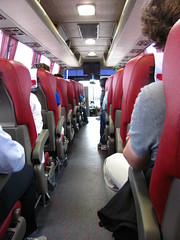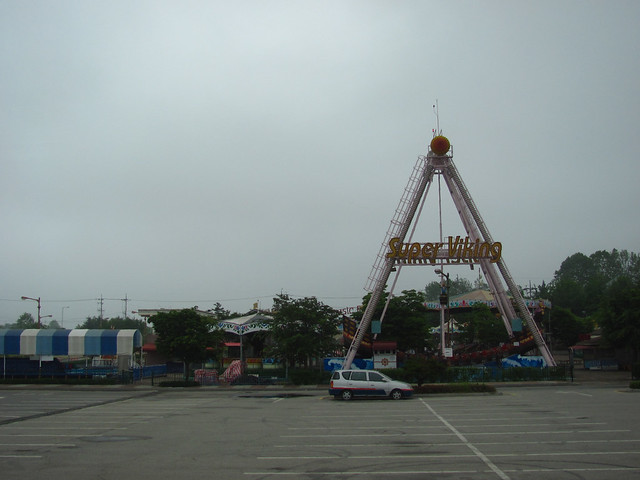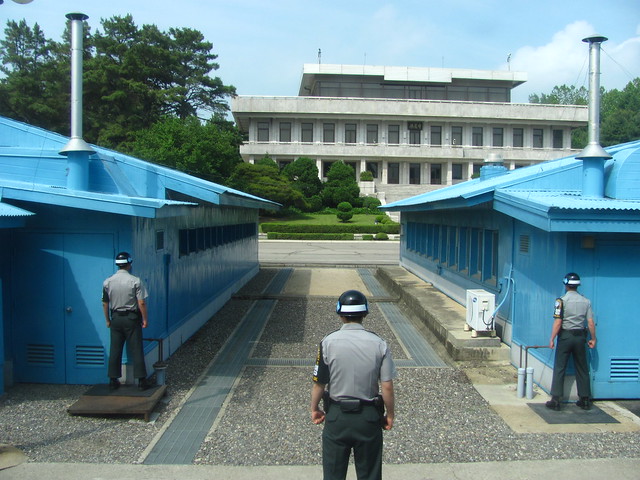Paju & Panmunjom, South & North Korea – Thursday, June 9th, 2011
What weird world is this? A war that still hasn’t been resolved over sixty years after it began, numerous landmines still scatter a 4km wide, 250km long no-man’s land, splitting a country now controlled by two radically opposed ideologies, their governments backed by the world’s two strongest superpowers, and in the middle of all that they decide to bring in… tourists?
 That’s right, one of the most popular tourist activities if you’re visiting Seoul is to take a chartered tour of the Korean Demilitarized Zone, including to the Joint Security Area at Panmunjom. Or so they say. Tours to the JSA are often cancelled last minute due to any countless number of diplomatic issues, not least of which are when hostilities occasionally break out, such as the bombardment of Yeonpyeong island that occurred six months before my visit, coinciding with the week I confirmed my travel plans to South Korea and Japan. I wasn’t deterred. Six months ago I figured, what more could possibly go wrong between then and now? Full nuclear outbreak?
That’s right, one of the most popular tourist activities if you’re visiting Seoul is to take a chartered tour of the Korean Demilitarized Zone, including to the Joint Security Area at Panmunjom. Or so they say. Tours to the JSA are often cancelled last minute due to any countless number of diplomatic issues, not least of which are when hostilities occasionally break out, such as the bombardment of Yeonpyeong island that occurred six months before my visit, coinciding with the week I confirmed my travel plans to South Korea and Japan. I wasn’t deterred. Six months ago I figured, what more could possibly go wrong between then and now? Full nuclear outbreak?
When the day arrived I had the idea to wear my “Long Live Chairman Mao” novelty t-shirt I got in Hong Kong for this tour. The whole event was shrouded in an eerie postmodern specter atop the grave of a thoroughly modern war, causing the spectrum between very serious and the very ridiculous to bend around and cross back over itself. Even the name is the greatest of ironies; a demilitarized zone in one of the most permanently militarized places on the planet. There seemed little else to do but go all-in.
Case in point: after getting picked up by the tour bus and riding some distance outside of Seoul towards the DMZ, our first destination was none other than an amusement park. Wait, what?
As our tour guide explained, Pyeonghwa Land was built specifically within viewing distance across the North Korean border so that the northern surveillance crews would slowly be consumed by jealousy and a desire to defect after seeing how much fun everyone in the south was having. “It’s psychological warfare,” our guide told us half seriously, half ridiculously, as he gestured toward the silent, sad-looking rocking ship ride. No, we would not be riding anything today.
Our next stop was at Dorasan Station, a train station built in 2002 just 650 meters from the southern boundary of the Demilitarized Zone. The purpose of the station was to re-connect the Gyeongui rail line between Seoul and Pyeongyang that was broken during the Korean War. For a brief period around 2003 freight trains actually did run between North and South carrying industrial supplies as part of a cooperation agreement, but that quickly ended and the station has served as a silent symbol for reunification ever since.
This way to Pyeongyang. As soon as the next train arrives…
Also symbolic, if this rail line ever were to reconnect with the North, it also would mean that South Korea would be connected to a larger Trans Eurasian Rail Network. Take the train all the way from Busan to Paris if you like.
As the tour went on it increasingly became more and more controlled. A member of the South Korean armed forces would chaperone our tour bus (all Korean men are required to complete two years of military service), and strictly no photographs were allowed on the bus while in transit between locations the closer we got to North Korea. There wasn’t much of interest to see anyway. The next stop was to the DMZ Pavilion, where we watched a short propagandistic film detailing the history of the Korean war and the South’s economic miracle that has allowed it to become better prepared and more prosperous than the North in every way imaginable.
The big attraction here is a tour of the Third Tunnel of Aggression. In the 1970’s the North was digging tunnels towards the South in preparation for a military invasion. The South discovered four of these tunnels, including this third one dug some 70 meters below the ground. There were traces of coal lightly covering some of the walls and the North claimed it was the work of lost coal miners, even though no coal deposits in the area. But points for creativity. Today you can ride this inclined shuttle down into the tunnel and explore a short section, where it has since been walled off. It’s certainly a eerie place to explore, not least of which is to consider what’s at the other end of this tunnel. Strictly no photos are allowed down there.
A short drive away was the Dora Observatory, which contained a large viewing platform that overlooks the demilitarized zone and the North Korean “Peace Village,” which the South Koreans refer to as the “Propaganda Village.” This is a popular location as it’s one of the only places that one can directly view the North from a high vantage point, including if the skies are clear the world’s fourth-tallest flagpole belonging to the North (constructed after the South so offended them by building their own tall flagpole).
While they had a number of binoculars available for rental, again there were strict restrictions on cameras and recording devices. No photos were allowed past this yellow line, presumably to prevent the North or anyone else from mapping the full DMZ or tracking any potential activity. But it seemed to serve little practical purpose upon consideration, given that holding a camera up high just behind the line will get you practically the same results. The rule essentially became “no short people allowed to take photos of North Korea.”
Our next destination was Imjingak Resort in Paju. Despite the name it’s not really a resort, but more of a place of remembrance for families divided by the Korean war. In some ways this was the most powerful section of the tour, as the focus wasn’t on trying to rubberneck a glimpse of whatever craziness was going on in the DPRK, or chronicling the history of the ridiculous games of brinkmanship and propagandistic braggadocio played between the North and South. Instead, it made tangible the human tragedy of lives lost and families forever torn apart by the separation of this country that’s still felt to this very day.
Imjingak Resort contains the Bridge of Freedom, a disused railroad bridge across the Imjin river. While the bridge is blocked, it’s been transformed into a memorial for Koreans to visit to remember their loved ones left behind on the other side.
Also found at Imjingak Resort is this old bullet-riddle steam locomotive. The engine had been parked at the now-defunct Jangdan station, after it was fired upon by US troops in 1950 to prevent it from being used by the North Koreans. It’s been collecting rust ever since.
At the resort we also took a break for lunch with our group, a meal of Korean barbecue with banchan. It was easily the best meal I had while in Korea, given that I didn’t have to deal with the complexities of choosing what to order for myself and hoping it comes in a portion size suitable for a single person.
 Finally, it was time for the main destination: the Joint Security Area at Panmunjom. I’ll be honest, I had little idea what to expect here, but after the tour stops so far I figured I’d be best served setting my expectations low. How much of North Korea would we really be able to see from the areas we would be allowed into? Cameras I figured would be straight out, given the increasing restrictions at every step along the way. The bus ride there was in lockdown mode, with the military chaperone on the lookout for any cameras or phones that might come out of a pocket. I’d only have my memories of a few buildings from a distance, was my expectation.
Finally, it was time for the main destination: the Joint Security Area at Panmunjom. I’ll be honest, I had little idea what to expect here, but after the tour stops so far I figured I’d be best served setting my expectations low. How much of North Korea would we really be able to see from the areas we would be allowed into? Cameras I figured would be straight out, given the increasing restrictions at every step along the way. The bus ride there was in lockdown mode, with the military chaperone on the lookout for any cameras or phones that might come out of a pocket. I’d only have my memories of a few buildings from a distance, was my expectation.
We finally arrived. There was a palpable tension on the bus. Everybody was led off, around a large concrete building. South Korean soldiers stand guard all over the place, unarmed but with fists tightly clenched and concealed behind a pair of dark shades, looking like we just wandered into a casting call for an 80’s action movie. (It’s not that far off. Much of what goes on in the JSA is designed as theater, especially for people still operating within the mindset of previous decades. Wait until you see the North’s uniforms…)
Around the large building we’re now facing three light blue conference rooms straddling the North-South border. At this point the restrictions entered the highest level yet. No sudden movements. No hand gestures or anything that could resemble an attempted communication with the North. No laughing either, but a light smile is probably okay.
But then came the real surprise: “Also, you take your cameras out now.” Wait, for real? Okay then…
I suppose it makes sense, as unlike the rest of the tour stops so far, there’s nothing within this part of the JSA that could be considered secret from the North Koreans, and maybe a tourist will catch an image of a North Korean general doing something dumb or against the joint rules that the South can use against them. Whatever the reason, we were soon escorted into one of the blue buildings.
These conference rooms are used for meetings between the two sides, straddling the border to allow each to sit across the table from each other while remaining within their own territory. However, each building is wholly owned by one side or the other, resulting in an odd duality where you can remain in South Korean jurisdiction while standing in North Korean territory. As the tour guide explained this, the question on everyone’s mind was: will they enforce that invisible boundary when tourists are inside?
 The answer: No! I was one of the first in the group to take a few tentative steps onto the other side of the room. No alarms went off, no North Korean guards came rushing in, nothing exploded as if by booby trap. There I was, officially standing in North Korea. Of course I had to get my photo taken, and be a smart ass about it. (I had already committed to the Communist t-shirt and that somehow didn’t get me in trouble, so of course I had to go all the way.)
The answer: No! I was one of the first in the group to take a few tentative steps onto the other side of the room. No alarms went off, no North Korean guards came rushing in, nothing exploded as if by booby trap. There I was, officially standing in North Korea. Of course I had to get my photo taken, and be a smart ass about it. (I had already committed to the Communist t-shirt and that somehow didn’t get me in trouble, so of course I had to go all the way.)
Back outside we had the opportunity for more photos on the steps of the South’s Freedom Building, overlooking the set of conference rooms and the North’s Panmungak Hall.
I thought my mind had already been blown by the fact that just moments ago I was STANDING ACROSS THAT LINE GETTING MY PICTURE TAKEN IN FREAKING NORTH KOREA!
But then a North Korean soldier briefly came out of Panmungak Hall, dressed in full Cold War-era regalia that never lost fashion in the North. I quickly try to get a photo of this, and as I raise my lens, I quickly realize HE IS STARING DIRECTLY BACK AT ME THROUGH BINOCULARS!!!
If I had any doubts earlier whether the tour would be worth it, I now had an extra country credit and maybe even made a new acquaintance who was intrigued by the white kid with the Mao t-shirt. There was no way anything else today would top this, although as we returned to the bus we still had a couple more landmarks to see from the windows.
First was the Korean Ax Murder Incident Memorial, dedicated to the spot where two U.S. soldiers were murdered in 1976 after a confrontation with the North over the pruning of a poplar tree that was blocking the South’s views. Eventually the North Korean soldiers grabbed the axes from them and went Jack Nicholson in The Shining on them. A large contingent of U.S. and South Korean forces returned the next day to cut down the tree completely in a show of force. The memorial was added in 1987.
Finally, the Bridge of No Return, which from 1953 to 1976 served as the point of prisoner exchange between the two sides. Fittingly named, as once anyone has crossed it, they’ve never gone back to the other side.
 It was nearly 3:30pm and time to return to Seoul. The tour of the DMZ and JSA had been a mix of many different emotions, often at the same time and with an air of befuddled bemusement to tie it all together. Even today I’m not quite sure what to make of the whole experience, although there’s no doubt it was one of the most unique tours I’d experience in all of Asia.
It was nearly 3:30pm and time to return to Seoul. The tour of the DMZ and JSA had been a mix of many different emotions, often at the same time and with an air of befuddled bemusement to tie it all together. Even today I’m not quite sure what to make of the whole experience, although there’s no doubt it was one of the most unique tours I’d experience in all of Asia.
To wrap this story up on one last weird note, I learned from some of my fellow tourists that tours of the JSA are not limited to the South. Despite their reputation, tours on the North side are decidedly more laissez-faire than the South, letting visitors explore more or less at their own leisure. In fact, it seems the Joint Security Area has largely outlived its diplomatic usefulness, and in 2018 it was agreed upon by both sides to utilize it primarily as a tourist attraction. Normally I’d crack a joke here about building an amusement park in the demilitarized zone next… but that was literally our first stop. If anything, the Korean Demilitarized Zone is testament to the creative ways people try to adapt when they find themselves within a fundamentally absurd situation.




















































Comments